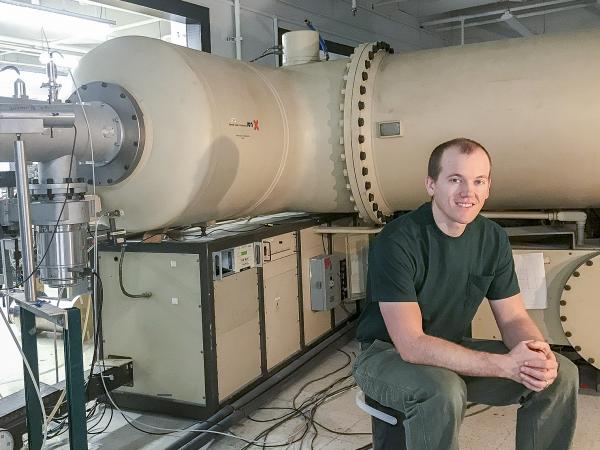
“It's useful to peek over someone’s shoulder," says Kevin Woller of the students he mentors. "The accelerator is a large machine. It’s not easy to put someone in front of it and say ‘OK, operate it!’"
Photo: Paul Rivenberg
Research scientist passes along the nuts and bolts of plasma research
December 26, 2018
A year after receiving his Sc.D from MIT, research scientist Kevin Woller is looking back. Years of study at Tarleton State University in Stephenville, TX, followed by graduate research at MIT’s Plasma Science and Fusion Center (PSFC), have indebted him to a long list of teachers and mentors. His appreciation may stem from his own experience advising his young colleagues. Early in his career he is already carving out a reputation as someone who can skillfully guide UROPs and visiting students to do their best work.
Woller credits physics professor Daniel Marble at Tarleton with setting him on the path to fusion research. His professor was studying gun barrel alloy composition in an ion accelerator lab that had been established for materials analysis.
“My project was to set up a target chamber in his lab that could be accessed remotely by high school students. [Dr. Marble] is a big advocate for education; he wanted schools to have access to university level research facilities.”
Also tasked with keeping the accelerator conditioned to take high voltages, Woller began working with plasmas, generating and using them as a source for the ion beam. He became even more familiar with plasmas when the ion source broke and he had to repair it.
“Once you start learning about plasma it points you towards fusion. Before then I was mostly interested in renewables – solar, wind, geothermal – all that kind of stuff. When I discovered there was fusion, that’s what led me to MIT.”
When he arrived for graduate studies at MIT, Woller was primed to do research in the Cambridge Laboratory for Accelerator Study of Surfaces (CLASS) under the supervision of Nuclear Science and Engineering professor Dennis Whyte, now PSFC director. As a user facility that housed an ion accelerator, the laboratory was available to interested researchers, inside or outside MIT. With his working knowledge of ion accelerators, Woller found himself beginning to mentor others with the help of his colleagues.
“It was just me and a few other grad students. There were UROPs working in the lab then, as there are today, and we would help them understand lab practices, how the accelerator worked, where the pitfalls could be.”
As a research scientist, Woller has become a reliable starting point for students and staff new to the PSFC. In the summer of 2017 he offered a project to visiting student Joran Savenije from Eindhoven University of Technology, Netherlands, focusing on lithium coating preparation and analysis, as well as deuterium plasma generation. In 2018, working with the MIT Summer Research Program (MSRP), he oversaw visiting student Christopher Reis’ work using ion beams to evaluate materials exposed in the Experimental Advanced Superconducting Tokamak (EAST) in China.
“At first, they are like shadows,” Woller explains. “It's useful to peek over someone’s shoulder. The accelerator is a large machine. It’s not easy to put someone in front of it and say ‘OK, operate it!’ I always try to explain the physical concept involved because I know that helped me learn the process."
Once he is confident his mentees understand how the accelerator works, he puts them in control of it and observes.
“I believe physically controlling the machines or tools is very helpful in the learning process,” he says. “I take the same approach with my children. I encourage them to use tools to fix toys that break.”
Both visiting students were moved to write thank you notes to Dennis Whyte for providing the opportunity, and for pairing them with Woller. Describing his time at the PSFC as “one of the greatest opportunities I have ever received,” Reis wrote, “I am especially thankful for Kevin’s delegation as my supervisor. I learned something new from him every single day we worked together these past two months.” Joran Savenije described Woller’s way of working and careful explanations as “probably the most valuable thing I took home with me.”
Woller, who continues to oversee UROPs, visiting students and postdocs, is full of praise for the colleagues he mentors, describing their work as “high-impact and technically challenging.” He credits Whyte for not only teaching him how to run the laboratory, but for modeling how to pass that knowledge on to others.
His primary mentors will always be his parents.
“Dad was into tinkering. If something broke he wanted to fix it. And I like to work in a lab with nuts and bolts and wrenches. Mom provided more of a way of thinking about things and going about doing things.”
Woller has been thinking about his undergraduate education, and the teachers who were key to his progress. With the rigors of writing a thesis behind him, he feels he may have time to write to his undergraduate professors and let them know where he is, and how their guidance helped. Dr. Marble has stayed in touch.
“He was the first to show me the ion accelerator,” says Woller. “He showed me the way to turn the knobs. Now I can tell him that I know there is a lot more to it than knobs and switches.”
Topics: Magnetic fusion energy, Accelerators & detectors, Dennis Whyte